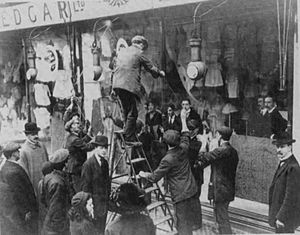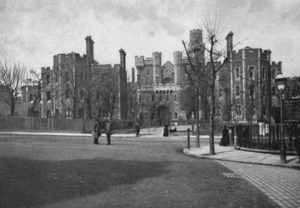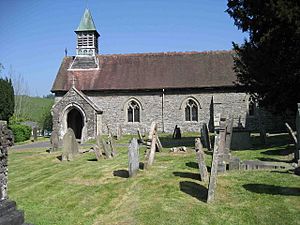Janet Boyd facts for kids
Janet Boyd (born Janet Haig; 1850 – 22 September 1928) was a brave member of the Women's Social and Political Union (WSPU). This group worked hard to get women the right to vote. Janet was a militant suffragette, meaning she took strong actions for her cause. In 1912, she went on a hunger strike in prison. For this, she received the WSPU's special Hunger Strike Medal.
Early Life of Janet Boyd
Janet Augusta Haig was born in 1850 in Marylebone, Middlesex. Her family was well-off. Her father, George Augustus Haig, was a merchant and landowner from Pen Ithon, Radnorshire, Wales. He was related to Douglas Haig.
Janet had two sisters who were also suffragettes. They were Charlotte 'Lottie' Haig and Sybil Thomas. Sybil later became Viscountess Rhondda. Janet's niece, Margaret Thomas, was also a feminist and suffragette.
In 1874, Janet Haig married George Fenwick Boyd. He was a lawyer. His father, Edward Fenwick Boyd, built a large family home called Moor House. This house was in Leamside, near Durham. Janet and George had four daughters: Sybil, Annie, Hester, and Janet. After George inherited Moor House, they all moved in.
When George Boyd passed away in 1909, Janet gained more freedom. This allowed her to join the important fight for women's suffrage.
Fighting for Women's Rights
Janet Boyd was very active in the women's suffrage movement. She often protested against unfair rules.
In 1911, a newspaper reported that Janet Boyd refused to pay her taxes. She owed £21. To raise the money, she held an auction at her home. A member of the WSPU spoke to the people gathered there. Janet sold a Spanish mantilla, a type of veil. Her gardener bought it, likely with money from Janet herself.
That same year, Janet joined a protest against the 1911 Census. Her name was not written on the census form. Instead, it said: '14 females passed the night here. As women are not counted as voters, neither should they be counted on this census.' This showed her strong belief that women should be recognized.
In November 1911, many suffragettes took strong action. This happened after a bill to give women the vote failed. About 223 suffragettes were arrested for breaking windows. Janet Boyd was one of them. She was arrested on November 19, 1911. She had broken a window in The Strand in London.
When she appeared in court, she said she was not guilty. She believed she was doing it for a good reason. She was fined a small amount for the damage. She was also sentenced to seven days in prison.
Janet was arrested again in March 1912. She and her cousin Florence Haig broke windows at a store on Oxford Street. The damage was valued at £66. Florence Haig said she would not stop fighting. She felt like a soldier who would not desert.
On March 19, 1912, Janet was sentenced to six months in Holloway Prison. While there, she went on a hunger strike. She was not force-fed, which means she was not made to eat. She was released in June 1912. For her bravery, the WSPU gave her the Hunger Strike Medal.
To keep spirits high in prison, the women created their own fun. Some, like Emmeline Pethick-Lawrence, told stories. Emmeline Pankhurst shared memories of the WSPU's early days. On June 10, 1912, three grandmothers in prison sang together. These were Gertrude Wilkinson, Janet Boyd, and Mary Ann Aldham. Another time, some women performed a scene from The Merchant of Venice.
Janet Boyd was one of 68 women who signed The Suffragette Handkerchief. This handkerchief was embroidered by prisoners in Holloway in March 1912. It is now kept at Priest House West Hoathly. Janet was one of only two grandmothers to sign it.
In May 1913, Janet Boyd continued her tax protests. Another auction was held at her home. Her friends and supporters attended, along with the tax collector. An Italian necklace was sold for £26. This was enough to pay the taxes and fees. It is thought that the necklace was returned to Janet later.
Later Years
Janet Boyd spent her later years at Moor House in Leamside, near Durham. She passed away on September 22, 1928, in Gotherington, near Cheltenham. Her name is on the Suffragette Roll of Honour. She is buried in St. Padarn's Churchyard, Llanbadarn Fynydd in Powys.




